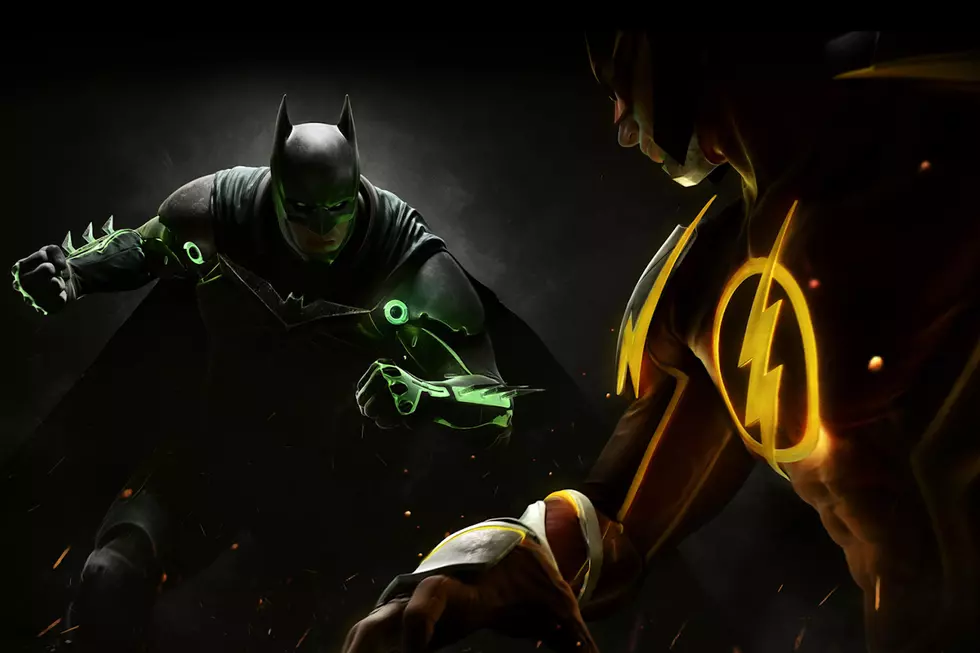
Bizarro Back Issues: Batman In The Worst Thanksgiving Ever (1954)

The time is once again here for Thanksgiving in America, and while most of us just use the holiday as an excuse to binge on turkey, there is a deeper meaning behind it. It's the day that we set aside to honor the time that the Native Americans helped out the Pilgrims, who would not have otherwise survived the harsh winter in their new home. Things eventually turned pretty sour between the two groups, but that first Thanksgiving stands as a testament to the power of people helping each other through the rough times.
However, Batman apparently never got the memo about brotherhood and equality, which is why a 1954 story in Detective Comics #205 found the Dark Knight traveling back in time to drop the hammer on Gotham City's indigenous population in the name of Bat-Imperialism and discovering "The Origin of the Bat-Cave!" It's one of our favorite crazy stories, and we're rerunning this classic Bizarro Back Issues feature this week in honor of the occasion.
 Despite being credited to Bob Kane, the story was produced by the unsung team of Bill Finger and Sheldon Moldoff, and it's worth noting that back at the dawn of the Silver Age, during the infamous "Sci-Fi Batman" years of the '50s, Batman ended up fighting against Native Americans a lot. Like, so often that when I decided I wanted to write about about this particular story, I had to read through three other comics about Batman getting his Custer on before I hit the right one, and there were two others that I didn't get to. I imagine it has a lot to do with the popularity of Westerns in the era, but it was one of the go-to plot devices for writers in the '50s.
Despite being credited to Bob Kane, the story was produced by the unsung team of Bill Finger and Sheldon Moldoff, and it's worth noting that back at the dawn of the Silver Age, during the infamous "Sci-Fi Batman" years of the '50s, Batman ended up fighting against Native Americans a lot. Like, so often that when I decided I wanted to write about about this particular story, I had to read through three other comics about Batman getting his Custer on before I hit the right one, and there were two others that I didn't get to. I imagine it has a lot to do with the popularity of Westerns in the era, but it was one of the go-to plot devices for writers in the '50s.
It occasionally happened in the present -- like with the introduction of Man-of-Bats, the Lakota Batman who recently returned in Batman, Incorporated -- but more often than not, the stories involved Batman hopping in his time machine and heading back in time to square off against what could charitably be referred to as "misguided stereotypes."
You know, I might've buried the most important part of that sentence in the middle, so just so we're on the same page about this: Back in the '50s, Batman totally had a time machine. But I'll get back to that in a minute.
What matters right now is that our story begins in the Batcave, with Batman doing the kind of regular maintenance any homeowner (or cave-owner, as the case may be) should always keep up on:

Before we move on, I just want to say how much I love that Silver Age Batman's Batcave just had straight up dirt floors, and even more, that Batman would do stuff like dig holes for his electronics while wearing his full costume. The dude could not wait to get home that night and start digging trenches in his anti-crime basement. He loves being Batman that much. And you just know Alfred is standing off-panel watching that and just silently gritting his teeth because he's the one who has to deal with the sweat-stains and bright orange clay when it comes to laundry time. As though clown-acid and paralyzing tree sap weren't enough already, Master Bruce?
Anyway, Robin's discovery of the old piece of pottery prompts Batman to start reminiscing about all the fun times he's had ever since he discovered the Batcave after he bought the house -- wait a second, after he bought the house?

Yes, according to Bill Finger -- who would probably know, I guess -- Wayne Manor is not Batman's ancestral home. Instead, it's just some house that he bought because it had the perfect crime-fighting headquarters: A barn. It's like he didn't even consider how goofy that would look if children had to look at drawings of a dude in a Bat costume in a barn twice a month.
Fortunately for readers who don't want to see Batman attempting to end the scourge of crime from a location more suited for square dances, it turns out that the mansion was built in defiance of any building codes, and he's never more than one weak floorboard away from plummeting into the dark and unforgiving depths of the Earth. Thus: The Batcave!

I really like those old cutaways and diagrams that they used to put into comics to illustrate stuff like this, almost as much as I like the idea that Batman used to just drive a car back to Bruce Wayne's house and park it in his barn.
With that revelation, you'd think that we would've hit about as much as we could get out of finding an "origin" for the Batcave, assuming that they didn't go back to the actual geological upheaval that created it a million years ago. But friends, this is the Silver Age, when there was no element of Batman's life so minute that it could not be explained to an extreme that even I (a man who actually makes his living explaining the minutiae of Batman), think is a little ridiculous. Thus, they go to get the pottery translated, only to find out that despite being 300 years old, it contains a cryptic reference to "a man with two identities."
Clearly, this can only refer to Batman himself, because he totally invented this whole "double identity" thing, and no one in history ever wore a mask before. So in order to find out just what's been going on in the Batcave, they decide they need to see things for themselves, and that brings us back to Batman's time machine:

Okay, okay, so the time machine doesn't actually belong to Batman. Instead, it's the property of one Professor Carter Nichols, who let his pal Bruce Wayne use his time machine whenever he wanted to. It is, to say the least, one of the stranger pieces of Batman's history, partly because it was described as some bizarre combination of hypnosis and actual time travel that made it difficult to figure out whether Batman and Robin were actually time traveling or just having the same crazy lucid dream, and also because IT IS A TIME MACHINE THAT BATMAN DOES NOT USE TO FIGHT CRIME.
Seriously, you'd think that when Batman heard the words "time machine," the first thing he would do is head to Crime Alley circa 20 years ago and start just going sickhouse all over Joe Chill. At the very least, you'd think he'd be using it to keep crimes from happening in the present, but no. He mostly uses it for... well, for going back to Ye Olde Gotham City and punching out the past, one stereotype at a time. Which is exactly what happens here:

For the record, the first thing that Batman and Robin do when they get to 1654 is to change into their costumes, presumably because their regular modern-day clothes were too conspicuous. What? Who are we to doubt the Darknight Detective's impeccable logic?
Yes, Batman sees two Native Americans -- Later referred to specifically as Huron -- chasing down a white dude and immediately decides it's time for a history-altering punch in the face. Of course the white dude is the good guy in this situation! He's in a comic book in 1954!
The Caucasian in question turns out to be one Jeremy Coe, a frontiersman engaged in some pretty aggressive enforcement of Manifest Destiny. He tells Batman and Robin his story and reveals that he uses the same cave that will eventually have Wayne Manor built over it as a headquarters. Looking back on it 60 years later, the entire thing could charitably be called... Actually, you know what? The hell with charity, this thing is straight up racist.

Sorry, Finger and Moldoff, I know you guys probably didn't know any better, but holy buckets, when you've got a dude actually saying "white men -- thank heavens!" and talking about how he needs to rid the world of the "redman savages," there's not a lot I can do here.
And then it gets worse, when you find out exactly how Coe's been doing his spying:

He's been dying his skin red in order to "mingle" with them. Again: there is no defense for this at all. It is blackface by another shade.
And then, as you might expect at this point, it actually gets worse. Batman decides that he might as well make things a little more efficient for Coe by helping him rig up an elevator for his horse and a 17th century crime lab. Then, since Coe is still laid up after being tomahawked, Batman decides to go ahead and dye his own skin to get things done.
What follows is a pretty monumentally uncomfortable sequence in which Batman strolls into the camp to check things out, gets caught in a rainstorm that washes off his dye, and then spends a couple of pages impressing the Native Americans with stuff like "batarang magic." Seriously, I don't even want to post those panels here. I heard Osamu Tezuka and Hergé read this issue and were shocked at how the creators portrayed different cultures. That's how bad it is.
In the end, Batman helps out Coe's folks and they manage to head back to the present, where he and Robin have a debate over whether they were actually back in the past or if they were just hypnotized:

If it's the latter, I'm going to go ahead and say that Batman's subconscious has some serious issues it needs to work through. Beyond the regular ones that go along with dressing up like a bat and hanging out in a cave all night, I mean.
One quick epilogue to the story before we close out: This story -- which reappeared in Batman Annual #1 along with other origins for Batman's equipment -- was undoubtedly an influence on Grant Morrison. After all, he was the writer who brought Carter Nichols back to comics after about 40 years of everyone doing their best to completely ignore any stories about him, for what at this point should be pretty obvious reasons. But it wasn't just Nichols that Morrison drew from: The entire idea of Batman going back in time and hanging out in past versions of Gotham City formed the basis for Morrison's The Return of Bruce Wayne, which even featured a group of Native Americans inhabiting the caves beneath what would later become Gotham. Not only was Batman firmly on their side in that story, in what now looks like an attempt to set the sins of previous creators right, they even become the direct ancestors of Bruce Wayne himself.
So in the end, as much as this story is an artifact of the past that, like the pottery in the Batcave, is probably best left forgotten, at least we can all be thankful that we've moved past caricatures like this.
More From Eagle 106.3










